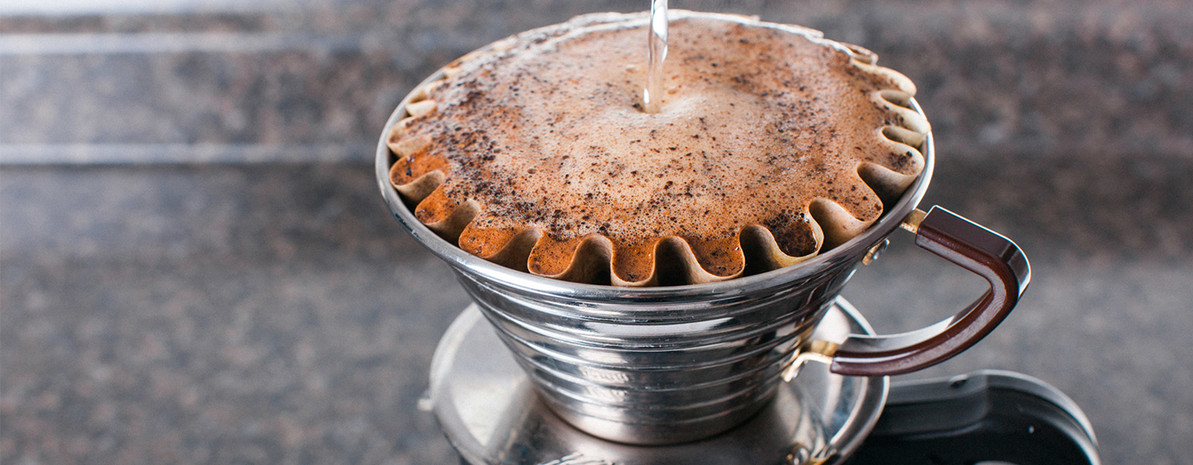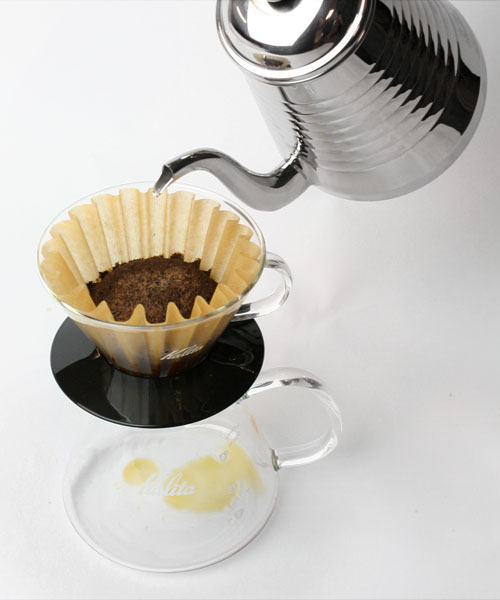Kalita Wave: Guest Barista Review - Part One
This is the first of our two part guest barista review on the Kalita Wave pour over brewing method. For these reviews, we bring you Collin Moody ( @CollinAMoody ) reviewing the 155 Series, and John Letoto ( @hermitudinous ) reviewing the 185 Series.
This is the first of our two part guest barista review on the Kalita Wave pour over brewing method. For these reviews, we bring you Collin Moody ( @CollinAMoody ) reviewing the 155 Series, and John Letoto ( @hermitudinous ) reviewing the 185 Series.
Collin Moody's review of the 155 Series Kalita Wave Dripper
The New Wave
Since the relatively recent return of manual brewing methods as legitimate brewing options in the professional specialty coffee industry, cone brewing devices such as the V60 and the Chemex have been the focus of discussion. The ubiquity of both brewers at this point in time makes the focus understandable, but there are certainly more diverse and perhaps more efficient brewers. Since Scott Rao’s book Everything but Espresso, the disadvantages of cone brewers have become more apparent, but there seemed to be very few viable alternative with such overwhelming support for both the classic Chemex brewer and the V60, both sold by Prima Coffee.
However, several companies (including Prima Coffee) recently began to import and proselytize the benefits of the Kalita line of brewers, focusing specifically on the Wave series and Kantan disposable drippers. The perceived benefits of flat bottom brewing geometry as well as the coffee geek early adopter syndrome led to the perfect storm of large early interest in these little Japanese brewers. While the rest of this article will focus on some theorization and opinions on the benefits of the Wave line of brewers, the most important aspect of these brewers is the ease and efficiency at which they brew. For the home user this is key, as it allows consistency and freedom that is not possible with other rather temperamental and inefficient brewing devices.
The 155 Series Method
The 155 Series, the smaller of the two available Wave sizes, is designed to brew within the range of 18-28g of coffee dose in the filter basket. This equates to somewhere in the ballpark of the 250-500ml range for the final brewed volume, depending on the user’s preferred ratio of coffee to water. I found my best results around a sweet spot of 24g of coffee, as it allowed for the water level to reach the top brewer without fear of flooding the brewing bed. Brewing to the capacity of these brewers also allows for minimal distance from the pouring kettle to the slurry, cutting down on uncontrolled turbulence to the top of the brewing slurry.
With such a small volume of brewing water, I preferred total brewing times within the 3:00-3:30 minute range with a pulse brewing style of multiple fills throughout the brewing time rather than continuous pouring. This style is necessary for the small brewing basket of the wave dripper, as it is quickly filled to the brim with the brewing slurry. My brewing time is structured with a 30-60 second bloom followed by 100ml fills over a period of 20 seconds with 10 second pauses to allow for the brewing slurry to drain partially, my final fill is finished at the 2:30-3:00 minute mark followed by a final draw-down time, allowing for a total brewing time of just about 3:00-3:30 minutes. Grind size is near impossible to communicate, but I found myself on the coarse end of what I would normally use for pour-over brewing, due to the small three hole style of the brewer restricting the flow of water.
While brew methods will always change based on each person’s preferences and variables beyond the control of prescription, one of the most important things about the Wave is the filter and the rinsing process. The filter somewhat resembles a paper wrapping of cupcake and is very delicate in maintaining the ridges that suspend the coffee bed away from the sides of the brewer--possibly allowing for better heat retention, but certainly forcing the coffee to flow through the bottom of the filter rather than out of the sides like one very popular brewer. In order to maintain these ridges, pre-rinsing means pouring straight on the bottom of the filter quickly, filling up the brewer to the brim to fully rinse all of the paper and heat up the brewer thoroughly. If one instead pours along the sides of the brewer, the ridges will droop and cause for an uneven and unpredictable brewing bed.
Results and Final Thoughts
Possibly due to the efficiency of the brewer, I found my normal coffee to water ratio to be unnecessarily high in dose. Through the use of the R2 mini refractometer and the MojoToGo app on the iPhone, I realized I preferred a distinctively new coffee to water ratio. I found myself using lower doses yielding a lower or equal total strength as before, meaning a slightly higher average extraction yield. Whereas with other brewers I am prone to dose somewhere around 24g to 370ml of water (19% Extraction, 1.40 TDS), with the Wave I much preferred a ratio of 24g to 450ml of water (22% Extraction, 1.30 TDS). The lower TDS is not so much necessarily strange, as sometimes I prefer a slightly lower strength coffee, but I found myself liking coffee best at an average extraction yield of 21-22% at a wide range of strengths.
Not all users will have the resources to measure these numbers to find a particular preference for Extraction Yield and Coffee Strength. However, it is beneficial information for users to know as it means using slightly less coffee to achieve an equal volume of brewed coffee out of the wave in comparison to other less efficient brewers. As well, my coffee off of the wave consistently remained very structured and balanced as it cooled in comparison to other manual brewing methods I often use, which will often lose structure and fall apart as they cool off completely.
Along with the choice of the 155 series versus the 185 series Wave, there is also the choice of different materials. The 155 series offer both Glass with a plastic base and Stainless Steel. While I generally prefer glass for brewing, I found myself leaning towards the benefits of the stainless for this particular brewer. Both are very lightweight, however the glass feels rather thin and delicate, while I personally prefer a slightly heftier material that is not prone to break, especially considering the high comparative price point of the wave. The stainless offers this, yet I worry somewhat about the possibility of rust buildup with running high temperature water over the shaped metal. The stainless material is perfect for travel, as one does not have to worry about any possibility of damage to the sturdy material, and the filters can even stack up in the brewer to protect the ridged shape.
- Collin Moody, Cafe Streets
Collin is from Houston, Texas but currently lives in Chicago and serves as the lead barista at Caffe Streets in the Wicker Park neighborhood of West Town, Chicago. He's an avid home brewer and has contributed some great posts to the coffee community. Check out his blog, brewtasterepeat . But for now, check out his review below:
Part Two of the Kalita Wave Barista Review can be found here .
For more product information check out the Kalita Wave Dripper listing!





